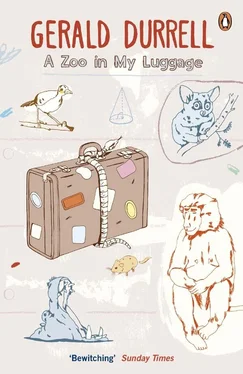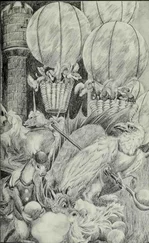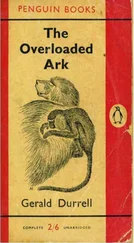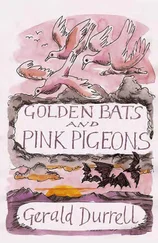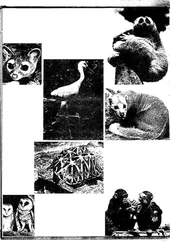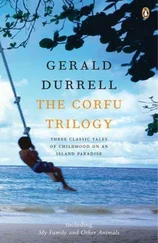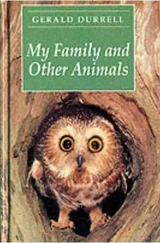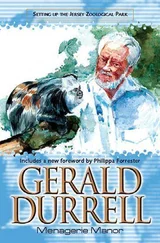Gerald Durrell - A Zoo in My Luggage
Здесь есть возможность читать онлайн «Gerald Durrell - A Zoo in My Luggage» весь текст электронной книги совершенно бесплатно (целиком полную версию без сокращений). В некоторых случаях можно слушать аудио, скачать через торрент в формате fb2 и присутствует краткое содержание. Жанр: Природа и животные, на английском языке. Описание произведения, (предисловие) а так же отзывы посетителей доступны на портале библиотеки ЛибКат.
- Название:A Zoo in My Luggage
- Автор:
- Жанр:
- Год:неизвестен
- ISBN:нет данных
- Рейтинг книги:4 / 5. Голосов: 1
-
Избранное:Добавить в избранное
- Отзывы:
-
Ваша оценка:
- 80
- 1
- 2
- 3
- 4
- 5
A Zoo in My Luggage: краткое содержание, описание и аннотация
Предлагаем к чтению аннотацию, описание, краткое содержание или предисловие (зависит от того, что написал сам автор книги «A Zoo in My Luggage»). Если вы не нашли необходимую информацию о книге — напишите в комментариях, мы постараемся отыскать её.
A Zoo in My Luggage — читать онлайн бесплатно полную книгу (весь текст) целиком
Ниже представлен текст книги, разбитый по страницам. Система сохранения места последней прочитанной страницы, позволяет с удобством читать онлайн бесплатно книгу «A Zoo in My Luggage», без необходимости каждый раз заново искать на чём Вы остановились. Поставьте закладку, и сможете в любой момент перейти на страницу, на которой закончили чтение.
Интервал:
Закладка:
So, to display her carnivorous and aquatic habits, I designed a set embracing a section of river bank. The undergrowth was carefully placed so that it would show off her perfect adaptive coloration to the best advantage. One morning, when the sky was free from cloud and the sun was in the right place, we carried the chevrotain cage out to the set and prepared to release her.
‘The only thing I’m afraid of,’ I said to Jacquie, ‘is that I’m not going to get sufficient movement out of her. You know how quiet she is … she’ll probably walk into the middle of the set and refuse to move.’
‘Well, if we offer her a snail or something from the other side I should think she’ll walk across,’ said Jacquie.
‘As long as she doesn’t just stand there, like a cow in a field. I want to get some movement out of her,’ I said.
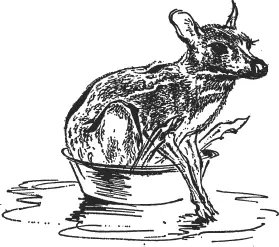
I got considerably more movement out of her than I anticipated. The moment the slide of her cage was lifted she stepped out daintily and paused with one slender hoof raised. I started the camera and awaited her next move. Her next move was somewhat unexpected. She shot across my carefully prepared set like a rocket, went right through the netting wall as if it had not been there and disappeared into the undergrowth in the middle distance before any of us could make a move to stop her. Our reactions were slow, because this was the last thing we had expected, but as I saw my precious chevrotain disappearing from view I uttered such a wail of anguish that everyone, including Phillip the cook, dropped whatever they were doing and assembled on the scene like magic.
‘Water beef done run,’ I yelled. ‘I go give ten shillings to the man who go catch um.’
The effect of this lavish offer was immediate. A wedge of Africans descended on to the patch of undergrowth into which the antelope had disappeared, like a swarm of hungry locusts. Within five minutes Phillip, uttering a roar of triumph like a sergeant-major, emerged from the bushes clutching to his bosom the kicking, struggling antelope. When we replaced her in her cage she stood quite quietly, gazing at us with limpid eyes as if astonished at all the fuss. She licked my hand in a friendly fashion, and when tickled behind the ears went off into her usual trance-like state, with half-closed eyes. We spent the rest of the day trying to film the wretched creature. She behaved beautifully in her box, splashing in a bowl of water to show how aquatic she was, eating beetles and snails to show how carnivorous she was, but the moment she was released into the film set she fled towards the horizon as if she had a brace of leopards on her tail. At the end of the day, hot and exhausted, I had exposed fifty feet of film, all of which showed her standing stock still outside her box, preparatory to dashing away. Sadly we carried her cage back to the Rest House, while she lay placidly on her banana-leaf bed and munched beetles. It was the last time we tried to photograph the water chevrotain.
Another creature that caused me untold anguish in the photographic field was a young Woodford’s owl called, with singular lack of originality, Woody. Woodfords are very lovely owls, with a rich chocolate plumage splashed and blotched with white, and possessing what must be the most beautiful eyes in the whole of the owl family. They are large, dark and liquid, with heavy lids of a delicate pinky-mauve. These they raise and lower over their eyes in what seems to be slow motion, like an ancient film actress considering whether to make a comeback. This seductive fluttering of eyelids is accompanied by loud clickings of the beak-like castanets. When excited the eyelid fluttering becomes very pronounced and the birds sway from side to side on the perch, as if about to start a hula-hula, and then they suddenly spread their wings and stand there clicking their beaks at you, looking like a tombstone angel of the more fiercely religious variety. Woody would perform all these actions perfectly inside his cage and would, moreover, perform them to order when shown a succulent titbit like a small mouse. I felt sure that, if he was provided with a suitable background, I could get his display on film with the minimum of trouble.
So, in the netting room I used for bird photography I set to and created what looked like a forest tree, heavily overgrown with creepers and other parasites, using green leaves and a blue sky as background. Then I carried Woody out and placed him on the branch in the midst of this wealth of foliage. The action I wanted him to perform was a simple and natural one not calculated to tax even the brain of an owl. With a little co-operation on his part the whole thing could have been over in ten minutes. He sat on the branch regarding us with wide-eyed horror, while I took up my position behind the camera. Just as I pressed the button he blinked his eyes once, very rapidly, and then, as if overcome with disgust at our appearance, he very firmly turned his back on us. Trying to remember that patience was the first requisite of an animal photographer, I wiped the sweat from my eyes, walked up to the branch, turned him round and walked back to the camera. By the time I had reached it Woody once more had his back towards us. I thought that maybe the light was too strong, so several members of the staff were sent to cut branches and these were rigged up so that the bird was sheltered from the direct rays of the sun. But still he persisted in keeping his back to us. It was obvious that, if I wanted to photograph him. I would have to rearrange my set so that it faced the opposite way. After considerable labour about a ton of undergrowth was carefully shifted and rearranged so that Woody was now facing the way he obviously preferred.
During this labour, while we sweated with massive branches and coils of creepers, he sat there regarding us in surprise. He generously allowed me to get the camera set up in the right position (a complicated job, for I was now shooting almost directly into the sun) and then he calmly turned his back on it. I could have strangled him. By this time ominous black clouds were rolling up, preparatory to obscuring the sun, and so further attempts at photography were impossible. I packed up the camera and then walked to the branch, murder in my heart, to collect my star. As I approached he turned round, clicked his beak delightedly, executed a rapid hula-hula and then spread his wings and bowed to me, with the mock-shy air of an actor taking his seventeenth curtain call.

Of course not all our stars caused us trouble. In fact, one of the best sequences I managed to get on film was accomplished with the minimum of fuss and in record time. And yet, on the face of it, one would have thought that it was a much more difficult object to achieve than getting an owl to spread his wings. Simply, I wanted to get some shots of an egg-eating snake robbing a nest. Egg-eating snakes measure about two feet in length and are very slender. Coloured a pinkish-brown, mottled with darker markings, they have strange, protuberant eyes of a pale silvery colour with fine vertical pupils like a cat’s. The curious point about them is that three inches from the throat (internally, of course) the vertebrae protrude, hanging down like stalactites. The reptile engulfs an egg, whole, and this passes down its body until it lies directly under these vertebrae. Then the snake contracts its muscles and the spikes penetrate the egg and break it; the yolk and white are absorbed and the broken shell, now a flattened pellet, is regurgitated. The whole process is quite extraordinary and had never, as far as I knew, been recorded on film.
Читать дальшеИнтервал:
Закладка:
Похожие книги на «A Zoo in My Luggage»
Представляем Вашему вниманию похожие книги на «A Zoo in My Luggage» списком для выбора. Мы отобрали схожую по названию и смыслу литературу в надежде предоставить читателям больше вариантов отыскать новые, интересные, ещё непрочитанные произведения.
Обсуждение, отзывы о книге «A Zoo in My Luggage» и просто собственные мнения читателей. Оставьте ваши комментарии, напишите, что Вы думаете о произведении, его смысле или главных героях. Укажите что конкретно понравилось, а что нет, и почему Вы так считаете.
